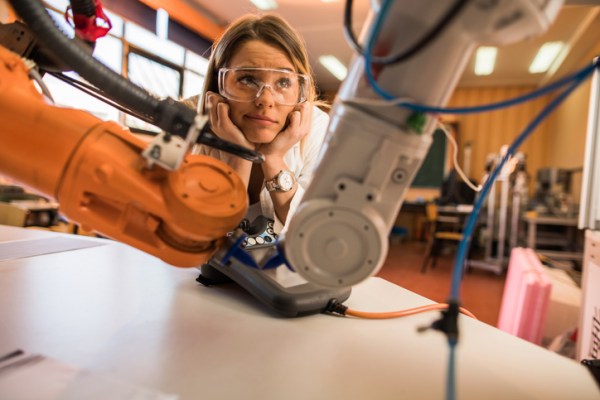At last week’s TC Sessions: Robotics+AI, I felt it was important to focus at least one panel on companies that are working to foster robotics startups. NVIDIA’s VP of Engineering Claire Delaunay and Freedom Robotics co-founder and CEO Joshua Wilson joined me to offer unique perspectives.
Both companies help provide building blocks for founders. NVIDIA is using some of its tremendous resources to create platforms like Isaac, designed to help prototype robots. And Freedom, a fairly fresh startup in its own right, is designing AI offerings to ease the deployment of those manner of systems.
But the first step of helping robotic startups help themselves is identifying why so many fail. Citing a handful of high-profile examples like Rethink, Anki, Jibo and CyPhy Works, I put the question to the panelists: even with a lot of funding and plenty of smart people on board, why do so many robotic startups fail?
“I think it’s just very hard to solve robotics problems today, which makes it still very expensive and very hard to get to even an MVP (minimum viable product) in the development cycle of the of the company,” said Delaunay. “Too many people focus still on robotics problem, not on the final problem, not on the on the business proposition.”
There are lots of reasons why robotics startups fail, but Delaunay honed in on one of the principle issues right out of the gate: unlike many other tech startups, robotics companies aren’t focused on solving a problem. But that’s often out of necessity. Imagine starting a car company but you first have to mine cobalt for the battery and pave the roads. Or, to use Delaunay’s analogy, building and manufacturing your own smartphone in order to launch an app.
That should give you some idea of what we’re working with here. While it’s true that robots have found great success in categories like factory automation and warehouse fulfillment, there are very few turnkey solutions in robotics. More often than not, success means having to build an entire stack. That might be an option for large corporations like Google that are exploring robotics projects internally, but it’s easy to imagine a new startup sinking as it works to plug all of the holes in its ship.
Robotics companies are particularly prone toward pivoting. iRobot is probably the classic example of a success story. CEO Colin Angle has a great talking point about not finding success as a roboticist until he “became a vacuum salesman.” The entry way to the company’s Bedford, MA headquarters sports a museum featuring shelves of failed attempts to productize both before and after Roomba, from baby dolls to war machines to lunar rovers.
iRobot ultimately succeeded thanks to a long runway and some DARPA funding. So, too, is the story of Boston Dynamics, which, after a couple of decades, is finally working to productize some of its impressive robots. More often, however, robotics see problems everywhere and work to solve them, overwhelming themselves in the process. See Zume as a recent example of a company that’s been focused on solving an increasing number of issues, from delivery to commercial kitchens to food packaging, ultimately stumbling along the way.
Conventional wisdom in robotics is that companies should focus on doing one thing well. That certainly still stands. “I think it’s really great that people believe in the long term vision that robotics can solve all of the major problems of our time,” says Wilson. “But I think the ones that are going to win right now are really the ones that focus on a niche problem, solving it making the technical trade-offs that leave a path in their product and into the market for more.”
But for roboticists, even solving that single problem can seem insurmountable. For all of the progress that has been made in the category, few companies have worked to clear the way for future startups to succeed. I often go back to one of the first robotics stories I covered back in 2012. A visit to Harvard’s Robot Hand Lab was eye-opening with regards to how a lot of robotics research is done.
When you can’t find the parts, sometime you have to improvise. For Robert Howe’s team, that meant building pressure-sensitive fingers with off-the-shelf smartphone barometers and submerging them in silicone inside of ice cube trays. Such things can work a lab or an at-home maker project, but the basic building blocks aren’t there to productize.
And in spite of on-going projects like ROS (Robot Operating System), it seems unlikely that any single solution will serve as a kind of Android equivalent for the robot world. “One of the problem of robotics is there’s so many different kinds of robots, they all have different bodies,” says Delaunay. “Somehow we have to extract what is common to 80% of robots and make it work for most of them. These exercises are very hard.”
Most of the roboticists I’ve spoken with have agreed that the process of launching a robotics startup will be significantly easier five to 10 years from now. Getting there, however, will require a lot of hard work from both established companies and startups alike to help construct the building blocks on top of which companies can create their hardware and software offerings with a focus on solving consumer and enterprise problems, rather than getting too bogged down in the details of how to get there.
